
(RNS) — When Hindus move abroad, there are a couple of sentimental things you can often count on finding in their suitcases — packets of homemade theplas or khakras, a traditional Indian outfit and an idol or photograph of their deity.
The food may not last long and the outfit will go in the back of the closet, but the idol or photograph will often take a prominent place as part of a home temple. Having a worship space in the home is one way young Indian expats can hold on to their traditions and cultural identity, especially when it’s not possible to visit a temple regularly. Even for those who are not very religious, it can be a space for meditation and reflection.
A home temple, also known as puja mandir, has been an integral part of the Hindu culture for centuries. It symbolizes the welcoming of God into one’s home and the importance of daily puja or worship. It’s also a form of gratitude for providing shelter, life and blessings. Some believe having a temple can create positive energy in their home and offer protection from evil.
Home temples usually house the photos or idols of the deities the family worships. Every morning, Hindus light a diya — an oil lamp — in front of the idol, make a small offering of food or flowers and recite shlokas or prayer verses as part of the daily ritual.
These temples vary in size and shape — from a simple recessed nook to an elaborate stone or wooden construction. According to the Vastu Shastra, or the traditional Indian architecture system, the temple must be in the northeast corner of the house to bring good luck and positive energy. If that is not possible, it can be placed in the eastern or northern corners of the house. It should also receive some amount of sunlight during the day. The temple cannot be placed next to a bathroom or toilet. If placed in a common area, some people like to cover their temples with curtains or doors.
Of course, cramped dorm rooms and tiny urban apartment spaces — the norm for students and young professionals — can make following these requirements a bit tricky. Here are a few who have tried their best to carve out a holy space — be it in a nook, a corner or a closet.
For good vibes
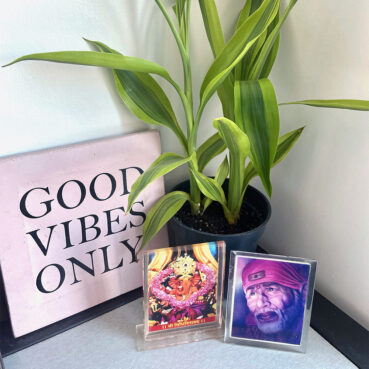
Photo courtesy of Anahita Khanna
Anahita Khanna’s parents packed photos of Lord Ganesha Sai Baba when she moved from New Delhi to New York in August 2021 to study journalism. Ganesha, the elephant god, is the remover of obstacles and one of the most worshipped Hindu gods. Sai Baba of Shirdi was a spiritual leader, also identified as a saint by many. Khanna’s family strongly believes it is a good omen to have a religious corner in your room and asked her to set them up in her room. “I’m a firm believer that there is some power that looks after you,” she said. “When I feel like I’m having a bad day or I feel like something is not going right for me, even just looking at the picture for a minute gives me hope for the day. That something good will happen to me.”
For Mom
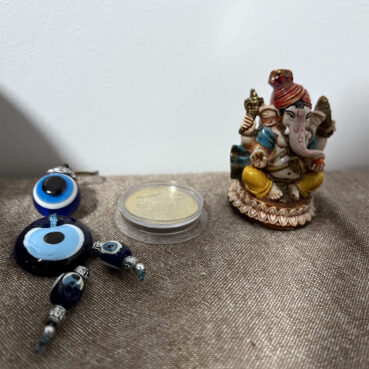
Photo courtesy of Archit Matta
Archit Matta, an engineering student at Columbia University, doesn’t consider himself religious but he belongs to a family that is. When he moved to New York in December 2020, his Punjabi mother requested he set up a small altar in his room. While the setup does not follow the directional guidelines mentioned in the Vastu Shastra, it’s always in his line of vision. Referring to the idol of Lord Ganesha on his desk, he said, “The corner is my devotion toward my mom and not necessarily toward my religion.”
RELATED: Gen Z is keeping the faith. Just don’t expect to see them at worship.
For new beginnings
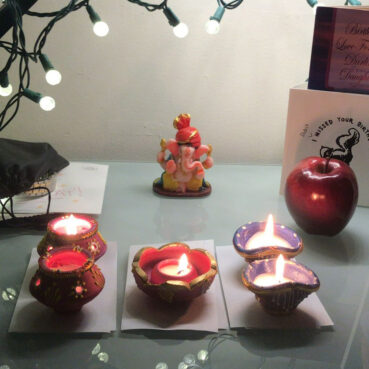
Photo courtesy of Isha Mishra
Reciting shlokas daily after the morning shower is a custom in Isha Mishra’s Brahmin household in India. She carried on that practice with her when she moved to the U.S. and bought a Lord Ganesha idol as it is considered auspicious for new beginnings. “It helps me focus or concentrate. It is kind of similar to meditation,” she said. “It is part of your morning routine — take a shower, recite some shlokas for five to 10 minutes.” Having studied Sanskrit in school also helps her understand the prayers instead of reciting them as a habit. Mishra likes to keep the idol on her study table — an area of knowledge — but had to move it to her dresser to ensure it was placed in the northeast corner of her room.
For staying grounded
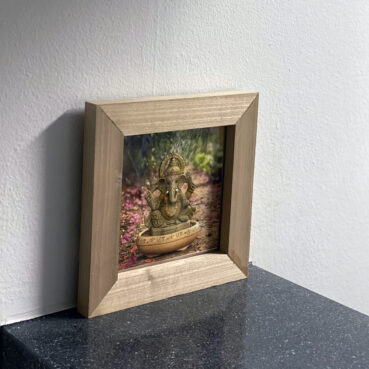
Photo courtesy of Kaushil Shah
Kaushil Shah grew up in a Jain household in Mumbai. Unlike some who create an elaborate setup, he chose to place a printed photo of Lord Ganesha, a Hindu deity, in a frame he made himself. The young architect was able to follow the orientation guidelines in his home in Indianapolis but said he does not partake in any daily rituals. To him, the corner is a way of staying grounded when everything around him is chaotic. “It has always given me peace of mind to look at something when I am stressed. I don’t pray every morning. It is just that once in a while, it will make me feel calm,” he said.
For tradition
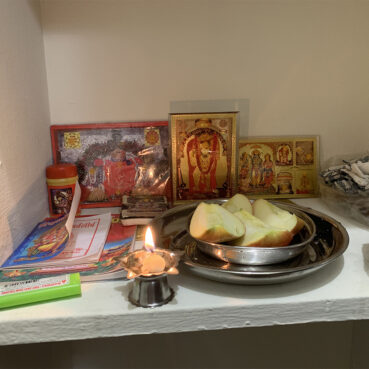
Photo courtesy of Kshitij Sharma
Back home in India, Kshitij Sharma’s parents light an oil lamp and recite prayers every morning. When he moved to the U.S. a few years ago, he continued these practices as well. His Nashville, Tennessee, home has a small corner where he has put up a few photographs of various deities in the Hindu pantheon that he got from India. He lights an oil lamp daily and places an offering of fruit, also known as prasad in Sanskrit. This offering is then considered sacred and is later consumed by the worshipper. “I don’t have that many photos. I only want a few I can take care of. If I can’t follow a particular ritual on my own, I don’t want to do that,” he said.
For spiritual connection
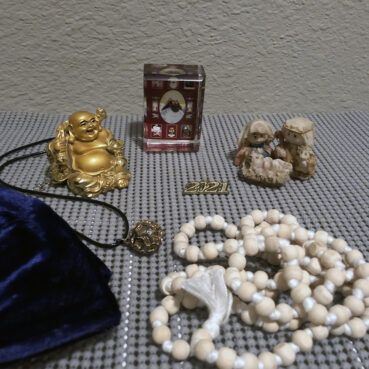
Photo courtesy of Navaz Bilimoria
Mumbai-born Navaz Bilimoria might be a Zoroastrian but she believes in all faiths. She often visits the fire temple in Houston, where she recently relocated. When she was studying in Pennsylvania last year, she attended the weekly mass. “I pray after my bath. I have a Laughing Buddha, I have Jesus, Mary and Joseph and I have my God.” She added, “I had a Ganpati too but it got lost in the move. I have the Hare Krishna beads as well.”
Ganpati is another name for Lord Ganesha and Hare Krisha is the colloquial term for the International Society for Krishna Consciousness, or ISKCON, an organization whose central beliefs and practices are derived from ancient Hindu scriptures such as the Bhagavad Gita and Srimad Bhagavatam.
For a sense of home
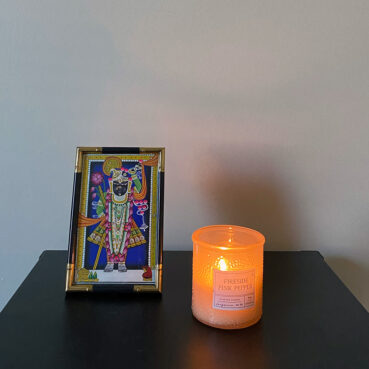
Photo courtesy of Priyata Bosamia
Priyata Bosamia thinks she is more spiritual than religious. She recently moved to Rhode Island from Mumbai to study design. Bosamia said, “The picture (of Shrinathji) which is there in my room … it brings a sense of comfort. I don’t pray to it every single day but that just being there gives me a sense of comfort, protection or a sense of connection to home.” But when she has a tough day, she often finds herself sitting in front of the photo of Srinathji, a deity followed by the Vaishnava sect, asking for guidance.
RELATED: How millennials make meaning from shopping, decorating and self-pampering
For the busy life
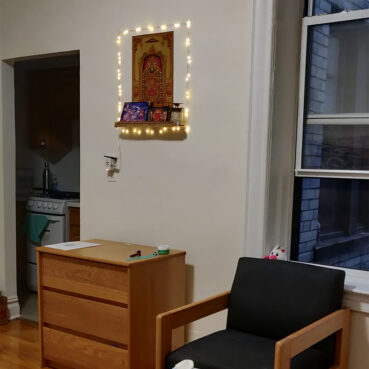
Photo courtesy of Shubhangi Sengar
“This is the closest I can get to a temple in New York,” said Shubhangi Sengar, referring to her shrine. “Ever since I have been living alone, I have always had a temple at home. At least a photo of Ganpati and a few other gods and goddesses.” Sengar, who is a business analytics student, tried to keep up with all the different customs and traditions, including the fasts. But as her coursework increased, it was difficult. Now, she lights an oil lamp every time she has a bath, and she recites some prayers if time allows. “Whether it is 10 in the night or the afternoon,” she said. “For me, it is more like I just want to have a moment with God whenever I have the time.”
For peace and quiet
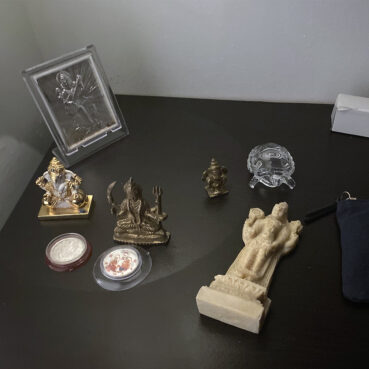
Photo courtesy of Trisha Sanghvi
Trisha Sanghvi is not one to pray daily. But she does pray once in a while or visit the temple when she wants to convey her gratitude, make a big decision or make a wish. She has set up a few idols that she brought along from India on her dresser in her New York apartment. “It is a space where there is not much noise. There is down time. There is peace basically,” she said. Sanghvi wanted to place it in the northeast corner but was unable to do so. “There is no space in New York,” she added.
